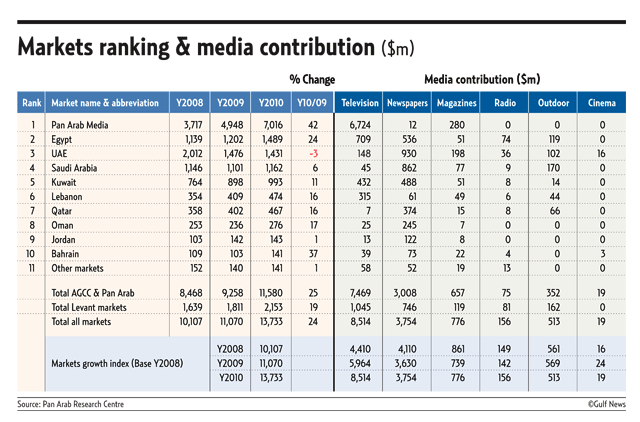
Dubai: Expectations soared, but reality failed to catch up. A lot was riding on the crucial fourth quarter for the local advertising sector to record significant gains in spending and more than compensate for the lacklustre three quarters prior to that.
However, things did not exactly pan out that way. The latest year-end numbers for UAE advertising spending show that though there was higher ad spending during the last quarter, it was not enough to make a decisive impact.
UAE advertisers spent $384 million (Dh1.4 billion) during the fourth quarter — a figure not far from the $360 million spent in the third quarter or the $338 million and $349 million in the first and second quarters respectively, according to data from the Pan Arab Research Centre. (The findings are based on published media rate cards.)
For the full year, advertising in the UAE totalled $1.43 billion, down marginally from $1.47 billion in 2009 and a more significant erosion of the $2.01 billion recorded in the glory year of 2008.
Television commercials
The UAE thus dropped to second place in the region's year-end rankings behind Egypt which, helped by a surge in spending on television commercials, posted a final tally of $1.48 billion for 2010.
In third place was Saudi Arabia with $1.16 billion — a 6 per cent gain over the 2009 numbers. But as the new year opens, is the UAE's advertising sector ready to confine the limp performances of the last two years to distant memory? Not yet, is the industry refrain.
"Ad spend is normally based on past/projected sales. Hence brands or services that did not ‘suffer' too much are likely to maintain their levels," said Tanvir Kanji, the head of Inca Tanvir.
"But payments are a perennial problem as companies are using ‘supplier credit' for cashflow as bank finance is still quite restricted."
More worryingly for the advertising agencies, there is no evidence of a marked improvement in client budgets for 2011. At least on the evidence so far.
"No earthshaking improvements are envisaged in most categories," Kanji added.
But clients and the agencies are hopeful of more favourable trends to be discernible by March or so.
They point to a noticeable improvement in consumer sentiment in recent weeks, and the fact that tourists are starting to return to Dubai.
If these trends hold, the ground would have been re-laid for advertisers to contemplate raising their spend. Even then, don't raise expectations too high, is the message coming out loud and clear.
"I don't see any significant increase in any category spending in 2011," said Azhar Seddiqi, general manager at media buying agency Magna Global.
"Although the market is more optimistic, no one is absolutely confident about what exactly will unfold during the rest of the year. Therefore a more cautious and safer approach is being taken by marketers."
But the steep discounts that many media outlets provided during the slump may now be over.
"It is highly likely that while the special deals from media owners [will] not disappear, they will try to further consolidate the tariffs," said Shaharyar Umar, the spokesperson at Parc.
"As it is, media tariffs are low in the region and media owners also provide various incentives and discounts to advertisers."
There is a broad consensus at work here on the "I don't think there will be any further downward revisions in media tariffs this year," Seddiqi said.
By accounting for 79 per cent of the overall spend, the print media in the UAE more than held its own against competing platforms. Television took up 10 per cent.
"UAE newspapers have always attracted the greatest share of advertising budgets in the local market," Seddiqi added.
"If a brand is targeting only one market like the UAE, TV is unlikely to be the most efficient way of doing this. This is because of the high cost of advertising on TV, the substantial investment required for the production of a commercial, and the wide reach of satellite TV beyond the target market," he said.
"These challenges can be overcome by local brands by using selective channels that cater mainly to the local market and by negotiating with the broadcast companies. However, the majority prefer to use other locally focused media outlets such as newspapers, radio and outdoor which have negligible spillover into other markets," he added.
"The cost of production for print, radio and outdoor ads is also less taxing on their budgets."
But across the region, television ruled as the favoured platform and increased its share of the overall spend from 54 per cent in 2009 to 62 per cent last year. This was brought about by a 43 per cent surge in spending on the medium.
Some of this may even have been at the expense of the region's print media, which saw its share plummet to 27 per cent from 2008's 41 per cent and 2009's 33 per cent.
Government tops advertisment spending charts
Dubai: Government and institutional spending were the heaviest advertisers in the UAE last year, followed by shopping malls and those entities related to the travel and tourism sector.
The top five advertisers were du, etisalat, Dubai Holdings, P&G and Unilever.
Meanwhile, the internet has yet to get sufficient advertiser attention despite web penetration in Saudi Arabia touching 48 per cent in 2009, and 69 per cent in the UAE.
"However, spending on the medium is negligible as of now and is unlikely to make any significant dent this year despite a lot of noise," said Shaharyar Umar, Parc spokesperson.












